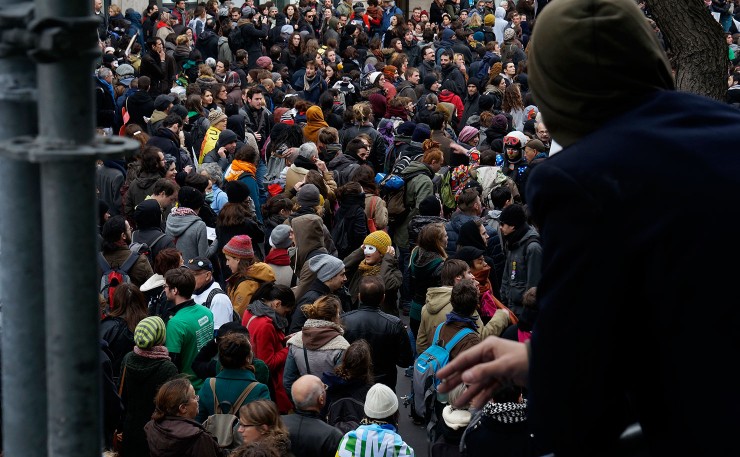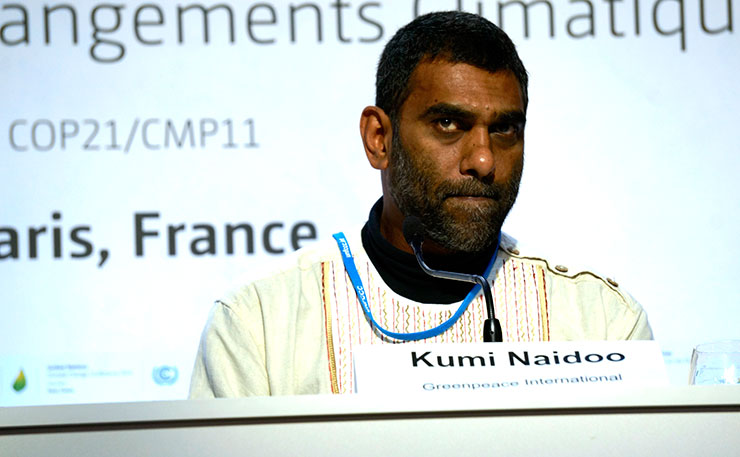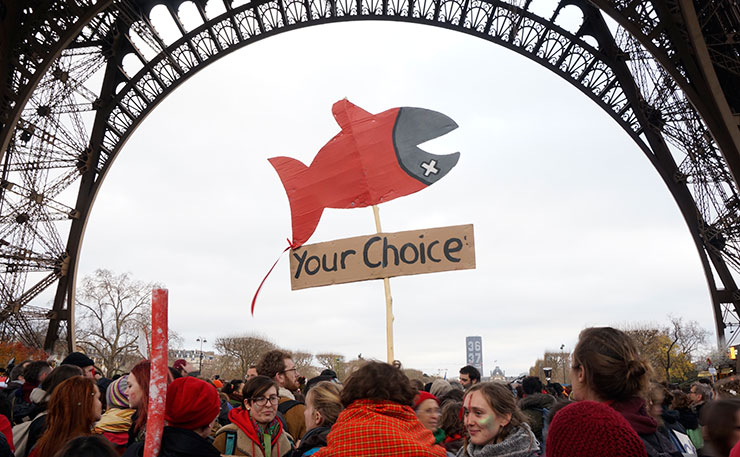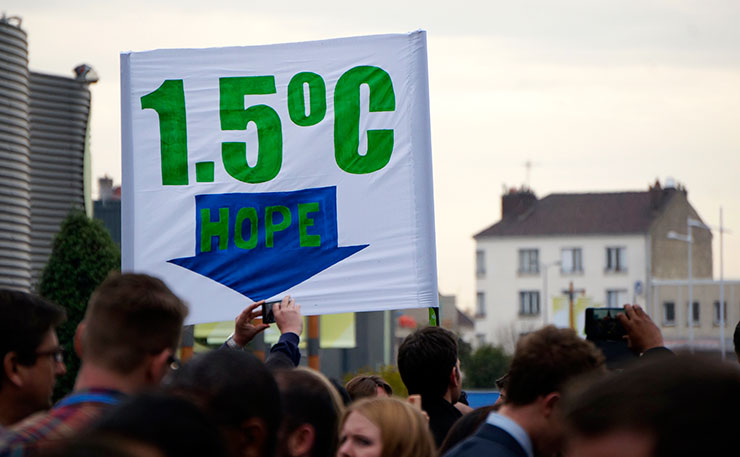The much-trumpeted successes at the Paris climate talks serve to highlight how far we have to go, not how far we’ve come. Thom Mitchell writes.
Just one day after the Paris climate talks, it’s time to put away the tambourines. We have built a splintered floor, but the house is still on fire, and we have not the time to celebrate what is, admittedly, an historic victory.
For the poorest and most vulnerable, inhalation has already set in. We are two thirds of the way to their ‘red line’ of a 1.5 degree rise in temperature, and as the most vulnerable nations made clear at Paris, anything more would be ruinous.
Thanking governments for vague and aspirational promises to “pursue” efforts to save the poor from a crisis they did not create is a luxury we cannot long afford. We have been gently ‘pursuing’ climate action at this international level for more than 20 years now, and emissions are up by around 60 per cent.
The people most at risk from climate change have not quite been thrown under the bus yet, but they have at least been denied a seat: If the Paris agreement is the vehicle to a safe and equitable future, it’s unclear how much fuel it has, but it’s obvious who owns the petrol station.
It’s us; rich nations like Australia that went to Paris with inadequate and immoral emissions reduction targets will need to do far, far more to ‘operationalise’ the framework that has been hammered out there.
The deal has its pros and cons – as you’d expect of an agreement involving nearly 200 nations – and it’s up to civil society and concerned citizens to force the ambition that’s needed by using the ‘hooks’ activists and civil society have squeezed out of Paris.

As Greenpeace International Executive Director Kumi Naidoo put it, “the measures outlined in Paris simply do not get us there. We have a 1.5 degree wall to climb, but the ladder isn’t long enough. The emissions targets on the table aren’t big enough.”
“It contains an inherent, ingrained injustice: The nations which caused the problem have promised too little to the people who are already losing their lives and livelihoods. This deal alone won’t dig us out of the hole we’re in, but it makes the sides much less steep.
“To pull us free of fossil fuels, we are going to need to mobilise in even greater numbers.”
And part of that challenge will be forcing governments to take the 1.5 degree goal seriously, once the hype dies down. The agreement actually takes as its ultimate goal a commitment to limit the rise in average global temperatures to less than two degrees, which is simply not ambitious enough.
The lower aspirational target of 1.5 degrees, “is a critical threshold for all temperature sensitive ecosystems and biodiversity,” said Samantha Smith, Leader World Wildlife Fund’s Global Climate & Energy Initiative.
“Just to say it simply; it’s the Arctic, it’s coral reefs, it’s tropical forests, but not least, it’s every person who is living in the Pacific Islands, and in all coastal areas.”
In a signal of how hard-fought the battle to meaningfully recognise 1.5 degrees will be, the emissions reduction pathway to actually take us there was weakened substantially in the final, much-vaunted, text.
“Parties aim to reach global peaking of greenhouse gas emissions as soon as possible… so as to achieve a balance between anthropogenic emissions by sources and removals by sinks of greenhouse gases in the second half of this century,” the agreement states.
That’s pretty woolly. It does not lay out cuts to be achieved in the near term, despite the fact that this is unarguably what needs to be done. And there’s no legal force to the text to hold nations to their already underwhelming commitments to reduce greenhouse gas emissions.
Almost all parties to the convention put forward plans to tackle climate change in the lead up to the conference – and that’s a world-first, and very useful thing – but the aggregate sum of these commitments puts us on a track to at least 2.7 degrees warming by the end of the century.
Across the board, there is a sharp disconnect between the goals being expressed, and the solutions being offered.

Crucially, the means of closing this gap came out somewhat fuzzy in the end, too: Also lacking teeth is a ‘ratchet mechanism’ to scale up the ambition of those nationally determined climate change plans until they’re commensurate with at least the two degree temperature goal.
The mechanism strongly encourages “progression” in countries’ level of commitment, but does not start, in affect, until 2023. This is widely seen as too late if we’re going to seriously retrain the emissions trajectory we’re on.
There will be a “facilitative dialogue” in 2018, but as the General Secretary of the International Trade Union Confederation, Sharan Burrows put it, “that review is empty in terms of the modalities to review ambition before 2020, and indeed in the context of individual [climate change plans]being analysed against the fair share of developed economies”.
“So you can have a shell of an agreement [but]if you’re really going to reach 1.5 degrees or as close to that as possible, then you must have a capacity to leverage up ambition. Sadly, that’s missing, in a context where we have barely 10 years of a carbon budget left,” Burrows said.
The framework around how those reviews will be made transparent, and how emissions will be accounted for after the five yearly cycle starts properly in 2023, is also quite unclear. Much has been deferred to future climate conferences.
As with all aspects of this negotiating process, there are very complex political reasons for that. But again, that doesn’t change the raw fact that climate change runs to a hard scientific deadline. Clearly, politics are being played over the bodies of the most vulnerable people, in nations like Kiribati, Bangladesh, Nicaragua and the Philippines.
Central questions around who will foot the bill of assisting these nations to adapt has also been forestalled in a number of serious ways. I won’t go into that in too much detail, because there’s a clearer example of how those responsible are dodging their dues.
The most simple example of how the survival of some of these nations has been politicised lies in the decision by countries like the United States to head off any claims for compensation or liability, despite that issue having been dropped months ago in an admirable compromise by the big bloc of developing nations known as the G77.

As well as the adaptation finance mentioned above, the concept of ‘loss and damage’ came to the fore in Paris. It’s about finance and other support for climate change impacts that cannot be adapted to, like having your nation inundated by rising seas or turned to desert by deepening droughts.
In a sign of bad faith and continued selfishness, the wealthy countries that are liable for the historic emissions sinking the Pacific moved to specifically exclude any future claim to compensation under the new international climate change regime, which will last for decades.
And in perhaps an even less justifiable blow to the rights of the most vulnerable, any reference to human rights, indigenous rights, and the more meaningful language around gender equity were consigned to the document’s preamble, where their legal status is far less certain.
It’s not that surprising, when you consider great bastions of human rights like Saudi Arabia, Burma and Sudan need to sign themselves up to this agreement.
But the result, as Naidoo points out, is that “one of the overall senses of the document is that where there are more aspirational positive commitments, it’s as vague as possible; [but]on the more negative side of the text, the downsides, the language is much more specific”.
That’s just the nature of these sorts of negotiations, which are decided by consensus.
To be fair, I’ve glossed over the huge amount of positives which emerged from the talks, but that’s because I think they’ve been trumpeted loudly enough in other media in the day since the Paris pact was sealed.
The point I try to make here is broadly in line with a comment made by Carroll Muffett, the President and CEO of the Centre for International Environmental Law.
“When you hear public outcry for a 1.5 degree target it is not because we are disconnected to what the political reality is, it is because we are connected to the scientific and social and human reality of the urgent need for action on climate change,” Muffett told media.
“We can no longer wait for international negotiations to solve the problems that we ourselves are solving faster, and must solve faster if we are going to save ourselves and human lives.”
What resounds most strongly in the wake of the Paris Agreement is not how far we’ve come, but how little this United Nations process has historically given us to celebrate, and quickly we must now translate its vague and often aspirational goals into action.
The Paris Agreement gave us some truly useful tools to put towards doing that, but there’s no time to waste, and the pressure which drove this success must be ramped up even further.
Donate To New Matilda
New Matilda is a small, independent media outlet. We survive through reader contributions, and never losing a lawsuit. If you got something from this article, giving something back helps us to continue speaking truth to power. Every little bit counts.





